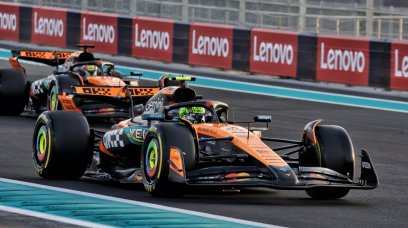F1 broadcast director Dean Locke has confirmed the sport is working with the team that developed the fastest drone camera in the world that recently took on Max Verstappen around Silverstone.
Formula 1 is continually pushing the boundaries regarding its presentation to its television audiences, with drones starting to play a role, albeit given the restrictions imposed on their usage.
Whilst camera drones are starting to feature in some sports, the difficulties in an F1 environment are considerable.
Locke, speaking to a small group of media including RacingNews365, explained: "We are always playing around with drones. They have been amazing for some sports. For us, it is still very challenging because the speed of the cars is ridiculously fast.
"And we have these events where we're getting over 400,000 people turning up over a weekend, so flying over crowds is quite difficult now.
"We had a meeting with the FIA (on Wednesday) to discuss various stuff, and we cracked a few areas in Vegas. We did some quite nice stuff there.
"So we are doing some work, not only on the speed of the drones but how light can we go. Can we go incredibly small, so if it does drop or does something, it does very little damage?
"We have been approached by some companies with these huge things, and it's just scary."
Locke has confirmed there will be "some drone stuff this year" which may yet come as a collaboration with the Dutch Drone Gods who have developed a system that was able to keep pace with three-time F1 champion Verstappen during the recent shakedown test of the RB20.
Initially, a prototype took on and beat former F1 driver David Coulthard in a straight-line test, with the 13-time grand prix winner behind the wheel of an RB8.
Viewed by others:
The team then took on the challenge of developing a drone, in tandem with Red Bull's engineers, that could keep pace with Verstappen around the twists and turns of Silverstone.
Locke has confirmed that F1 is now in discussions with the Dutch Drone Gods as to what could be possible at future F1 events.
"It's really interesting what they've done with it," said Locke. "Because it was a private test, they didn't have to adhere to 90% of the rules we have to, but we are talking to them.
"Is it something we could do? What do you do with it? It's really quick, but you can't fly over crowds, you can't cross the track, and it doesn't have a moving head or things like that, so it's got to follow the car (from behind) or to the side. It's quite tricky.
"But there are places, like the back straight in China, the back straight in Austin, a couple of areas where we plan to talk to them about it."
An additional problem is ensuring the signal strength to control the drone is maintained over what would be a densely populated environment given the crowds that attend races.
"Getting fast, good quality signal off a drone, with low latency, in the most crowded RF set up on the planet is very, very challenging," said Locke, who confirmed latency signal tests were being conducted with a drone at Turn 1 at the Bahrain International Circuit, scene of this week's season-opening race.
"It worked well in testing, and then everybody (teams, fans) turns up and it doesn't work quite as well," he remarked.
"On paper, it should work from five kilometres away, and that is half a kilometre, so lots of challenges, but we do intend to do a few extra bits around that as well."
Don't miss out on any of the Formula 1 action thanks to this handy 2026 F1 calendar that can be easily loaded into your smartphone or PC.
Download the calenderMost read
In this article













Join the conversation!